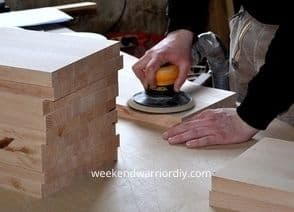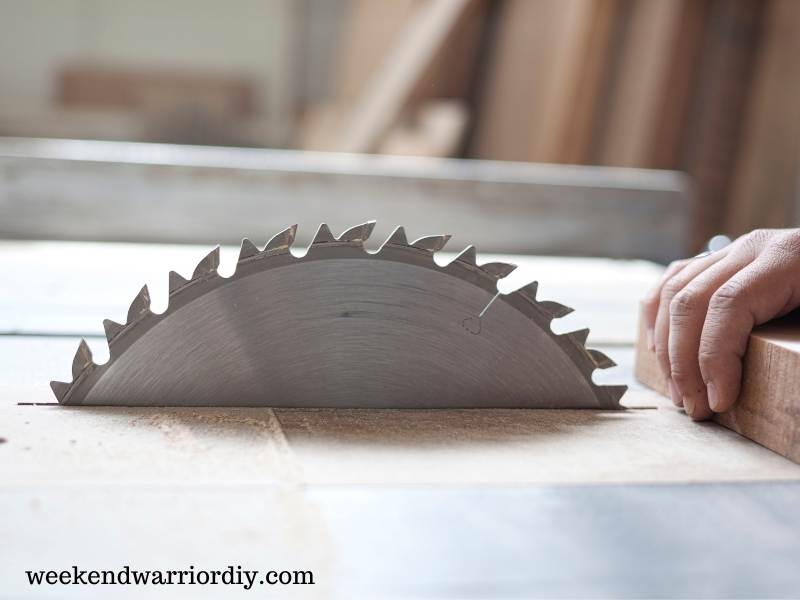Alright, let’s kick things off with a little chat about why keeping your table saw in tip-top shape is so darn important. Picture this: your table saw is like the MVP of your workshop, the go-to tool for tackling all sorts of woodworking projects.
Whether you’re a seasoned pro who’s been crafting masterpieces for years or a newbie just dipping your toes into the world of woodworking, one thing’s for sure: maintaining your table saw is an absolute must.
Now, I know what you’re thinking—why bother with maintenance when it’s just gonna get dirty again the next time you fire it up? Well, my friend, let me tell you: neglecting your table saw’s maintenance is like neglecting to change the oil in your car.
Sure, it might run okay for a little while, but eventually, things are gonna start grinding to a halt. And when it comes to your table saw, that could mean anything from wonky cuts to downright dangerous situations.
Understanding Your Table Saw
But fear not, my woodworking warriors! Before we dive headfirst into the wonderful world of maintenance tips, let’s take a moment to get to know our trusty sidekick a little better.
Your table saw is like a symphony of moving parts, each one playing its own special role in helping you bring your woodworking dreams to life. From the blade and arbor to the rip fence and miter gauge, understanding how each piece fits into the puzzle is key to keeping your saw running smoothly.
So, grab yourself a cup of coffee (or your beverage of choice) and pull up a chair. We’re gonna take a little tour of your table saw and get to know it like the back of our hand.
Because trust me, when it comes to maintenance, knowledge is power—and the more you know about your trusty tool, the better equipped you’ll be to keep it humming along like a well-oiled machine. So, let’s roll up our sleeves and dive in!
Why Regular Maintenance Matters
Alright, let’s talk about why giving your table saw a little TLC on the regular is so darn important. It’s not just about making it look pretty—although that’s always a nice bonus—it’s about making sure it runs like a well-oiled machine and keeps you safe while you work. Think of it like taking your car in for a tune-up.
Neglecting maintenance on your table saw can lead to all sorts of headaches, from wonky cuts to downright dangerous situations. We’re talking decreased cutting accuracy, a higher risk of accidents, and even the possibility of your trusty saw throwing in the towel way before its time.
So, do yourself a favor and make regular maintenance a top priority. Your fingers—and your projects—will thank you for it!

Essential Tools and Supplies for Maintenance
Alright, folks, let’s talk tools of the trade. When it comes to keeping your table saw in tip-top shape, you’re gonna need a few trusty sidekicks in your corner. Think of them as your maintenance squad, ready to tackle any dust bunny or misalignment that comes their way.
You’ll want to stock up on essentials like brushes and compressed air to give your saw a good old-fashioned cleaning. And hey, don’t forget about the lubricants! Silicone spray or paste wax will keep those moving parts humming along like a well-oiled machine.
And last but certainly not least, you’ll wanna have some alignment tools handy—think dial indicators and combination squares—to make sure everything stays nice and straight. With these tools at your disposal, you’ll be ready to take on any maintenance task that comes your way like a pro.
Cleaning Your Table Saw
Alright, folks, time to roll up those sleeves and get down to business—cleaning your table saw! This ain’t just about making it look pretty (although that’s a nice bonus), it’s about keeping it running like a well-oiled machine.
Dust and debris can wreak havoc on your saw’s performance and safety, so regular cleaning is key. Grab yourself a trusty brush and some compressed air, and get to work! Give that blade, table surface, and any other nooks and crannies a good once-over to clear out any gunk that’s built up.
Trust me, your saw will thank you for it with smoother cuts and fewer hiccups along the way. So, don’t be shy—get cleaning and keep that saw running like a dream!
Checking and Adjusting Blade Alignment
Alright, let’s talk about getting your blade in line—because when it comes to woodworking, precision is key! Blade alignment isn’t just about making sure your cuts look good (although that’s definitely a bonus), it’s also about staying safe in the workshop.
Think of it like tuning up your car before a long road trip—checking and adjusting the alignment of your blade ensures it’s parallel to the miter slot and fence, which means straight and consistent cuts every time. So, don’t skip this step! Make it a regular part of your maintenance routine to keep your saw running smoothly and your fingers intact.
Lubricating Moving Parts
Now, let’s talk about keeping things moving and grooving in your table saw. Just like a well-oiled machine, your saw’s moving parts need a little TLC to keep them running smoothly. So, grab your trusty lubricant and get to work! Hit up those arbor bearings, elevation and tilt mechanisms, and sliding surfaces like you’re giving them a little spa day.
Regular lubrication not only prevents friction and wear but also keeps your saw humming along like a well-tuned instrument. So, don’t be shy—show those moving parts some love and watch them thank you with smooth, effortless operation.
Inspecting Safety Features
Last but certainly not least, let’s talk about keeping yourself out of harm’s way. Your table saw’s safety features are like your trusty sidekicks—they’re there to watch your back and keep you safe while you work.
So, make sure to give them a once-over every now and then. Check in on that riving knife, blade guard, and anti-kickback pawls to make sure they’re in tip-top shape and ready to spring into action if needed.
After all, a little preventive maintenance goes a long way in ensuring a safe and productive woodworking experience. So, take a minute to give those safety features a pat on the back—they’re the unsung heroes of your workshop!
Maintaining Electrical Components
Alright, folks, let’s talk about keeping the sparks flying—in a good way! Don’t forget to give some love to the electrical bits of your table saw when you’re doing your maintenance routine.
Check out that power cord and plug like you’re giving it a little handshake—make sure there are no frays or signs of wear and tear that could spell trouble down the line.
And hey, while you’re at it, why not show some love to the motor and other electrical parts? A quick wipe-down and clean can help prevent overheating and those pesky malfunctions that can throw a wrench in your woodworking plans.
Storing Your Table Saw Properly
When it’s time to give your table saw a little rest, make sure you tuck it in nice and cozy. Find a spot in your workshop that’s clean and dry—think of it like finding the perfect spot for your favorite chair. And hey, why not give it a little extra protection with a dust cover or tarp? It’s like giving your table saw its own little blanket to snuggle up with, keeping it safe and sound from dust bunnies and moisture monsters while it’s catching some Z’s.
Troubleshooting Common Issues
Now, let’s talk about those moments when things don’t go quite as planned—those little hiccups in your woodworking journey. Blade wobble, motor acting up, or alignment throwing a curveball your way? Don’t sweat it! These are common issues that can pop up even with the best-maintained table saws.
But fear not, my woodworking friends! With a bit of troubleshooting magic and some adjustments here and there, you’ll have your trusty saw back in action in no time, ready to tackle whatever project comes your way.
Safety Tips for Table Saw Operation
Last but certainly not least, let’s chat about safety—because nothing ruins a woodworking party faster than a trip to the emergency room. When it’s time to fire up that table saw, make sure you’re suited up like a woodworking superhero. Pop on those safety glasses and hearing protection like they’re your secret weapons against flying wood chips and noisy saws.
And hey, don’t forget to brush up on your safe cutting techniques—it’s like knowing the secret handshake that keeps you and your fingers on good terms with your saw. So, remember folks, safety first, always and forever!
Conclusion
Alright, folks, let’s wrap it up! Taking care of your table saw is like giving it a big ol’ hug—it keeps it happy, healthy, and ready to tackle any woodworking project you throw its way.
Remember, proper maintenance isn’t just about keeping things shiny and looking good (although that’s a nice bonus), it’s about ensuring your safety and getting the best performance out of your trusty tool.
So, by sticking to the tips we’ve laid out in this article, you’re not just prolonging the life of your table saw, you’re also ensuring that every cut is as precise as can be and that you can keep on enjoying the wonderful world of woodworking for many years to come.
Whether you’re a seasoned pro or just starting out, a little TLC for your table saw goes a long way in making sure your workshop stays a happy and productive place.
Now, go forth, my woodworking warriors, and keep those saw blades spinning! With a well-maintained table saw by your side, there’s no project too big or too challenging for you to tackle. So, here’s to many more years of sawdust-filled adventures and the satisfaction of creating something beautiful with your own two hands. Happy woodworking, everyone!
Unique FAQs
How often you should clean a table saw
It’s crucial to clean your table saw regularly to maintain its performance and longevity. While some woodworkers may clean their saws after every use, a general rule of thumb is to clean it at least once a week, especially if it sees heavy use.
Dust and debris can accumulate quickly, affecting both the precision of your cuts and the lifespan of your equipment. Regular cleaning also helps prevent rust and corrosion, particularly in humid environments.
Should you use a lubricant on a table saw?
While it may be tempting to use whatever lubricant is on hand, it’s essential to use the right products for your table saw. Using lubricants specifically designed for woodworking machinery ensures optimal performance and protects sensitive components from damage.
Avoid using heavy-duty industrial lubricants or household oils, as these may not be suitable for the intricate mechanisms of a table saw. Instead, opt for products like silicone spray or paste wax, which provide smooth operation without attracting dust or debris.
What safety precautions to take when operating a table saw
Safety should always be a top priority when using a table saw. Start by wearing appropriate personal protective equipment (PPE), including safety glasses, hearing protection, and a dust mask.
Keep your work area clean and organized to prevent tripping hazards and ensure clear visibility of your workpiece and saw blade. Always use push sticks or other safety devices to keep your hands away from the blade, and never remove or disable safety features such as blade guards or riving knives.
Additionally, familiarize yourself with proper cutting techniques and always follow manufacturer guidelines and safety recommendations.
How do you know if your blade alignment is off?
Blade alignment is critical for achieving accurate cuts and preventing kickback. Signs of misalignment include burning or chipping of the wood, uneven cuts, and difficulty adjusting the fence or miter gauge.
To check for alignment issues, use a combination square or dial indicator to measure the distance between the blade and the miter slot at various points along the table. If you notice significant deviations from parallel, it may be time to adjust the alignment of your blade.
Why it’s necessary to unplug a table saw when not in use.
Yes, it’s essential to unplug your table saw whenever it’s not in use, even if you’re just stepping away for a moment. Unplugging the saw prevents accidental startups, which can pose a significant safety risk, especially if you’re working on maintenance or blade changes.
Additionally, unplugging your saw reduces the risk of electrical hazards, such as short circuits or power surges, which can damage your equipment or pose a fire risk. Developing a habit of unplugging your saw after each use is a simple yet effective way to enhance safety in your workshop.



